
|   |

|   |
25th year celebrations of Smitalay - Lekha Merchant e-mail: lekhamerchant@hotmail.com November 14, 2014 Smitalay is an eminent dance institution in the city of Mumbai, dedicated to teaching and performing Odissi. It celebrated its silver jubilee with a five day Odissi festival. Jhelum Paranjape established Smitalay in 1989 and named it in fond memory of her childhood friend, late actor Smita Patil. It is the dance wing of Sane Guruji Arogya Mandir. Smitalay is an Odissi dance school with a difference - stress is laid on teaching children from the underprivileged strata of society. It has a very active performing dance troupe, which excels at performing both traditional Odissi compositions as well as innovative choreographies dealing with various contemporary issues beyond mythology, like mathematics, ethno politics, Dalit movement, women’s education, mystic poetry, water conservation, anti-dowry subjects etc. The 5 day festival was held at various venues in Mumbai, making it possible for audiences all over the city to attend at least one of the shows. October 11, 2014
The first event held at Veer Savarkar Hall was dedicated to late Sudha Varde, a women crusader, and an active member of the Smitalay committee. It consisted of two women based presentations. The first, Bahinaai was based on poems by Bahinabai Choudhary, an illiterate Maharashtrian woman who recited these poems while doing household chores. She recited them in khandeshi, a dialect of Marathi spoken in the Khandesh region. Her poems are very simple but full of wisdom. They hold an important place in the annals of Marathi literature. These poems are set to music by Yashwant Deo, sung by Uttara Kelkar, with commentary by late Bhakti Barve. It was a treat to see these simple Maharashtrian rustic poems come to life through Odissi. The dancers dressed in Odissi costumes made from cotton Maharashtrian saris, danced to eight poems that talked about the transient nature of life, the greedy nature of man, the restless mind etc. Senior artiste of Smitalay, Ankur Ballal’s choreography brought out the meaning of the poems explicitly. The second, Savitri Vadatey was a dance- theatre production showcasing the work of Savitribai Phule (India’s first woman teacher, who fought against the barriers of caste, creed and gender in the 1800s). The music for this was composed by the Smitalay team: percussionist Rohan Dahale, sitarist Aparna Deodhar, singer/dancer Swapnil Mistry and Jhelum Paranjape. Deepti Rege and Dattatreya Mestri provided vocal support. Jhelum played Savitri and Dilip Tambe played Jyotiba (her husband). They were supported by dancers of Smitalay. The presentation opened with a powerful scene - the marriage of Savitri and Jyotiba. The entire cast was on stage. The mangalashtakam - wedding vows are written by Jyotiba himself. Savitribai’s views on primary education were beautifully portrayed through a dance performed in the Odissi style by school going girls in half-sarees to a poem “Saraswati chaha darbar.” The poem and the dance talked about how learning should be fun for girls. Savitribai and Jyotiba set up a school for girls in the 1800s.They were able to achieve a lot in the field of women’s education. This was beautifully portrayed through a dance based on a poem “chandramavalala, ugawalasurya” set to raag Kalawati ending in Bhairavi. It was the dance of hope and achievement, danced by Savitribai and Jyotiba. Later the entire cast joined them ending on a happy note with the traditional moksha. Some poems were recited on stage by film / television actress Suhita Thatte. Kudos to Smitalay for bringing to light the work of two Marathi poetesses through Odissi dance. October 12, 2014
The second event featuring Young Talent was held at Ravindra Natya Mandir. As the name suggests, young performers from Smitalay and other Odissi institutes of the city were given a platform to showcase their talent. This event was a tribute to the gurus of Odissi and their work. Guru Shankar Behera (Jhelum’s first guru, before she went to Kelucharan Mohapatra) was the chief guest for the evening. The program commenced with a mangalacharan performed by a group of very young dancers from Smitalay, many of whom were from underprivileged background and were dancing on stage for the first time. They certainly were not great, but showed promise. Choreography was by Jhelum Paranjape based on Shiva Upasanastotra. The second group of dancers was from Nrityanikunj, a dance school run by Ketaki Shetge and Dilip Tambe. They performed Batu, a pure dance item. Both Ketaki and Dilip learnt Odissi at Smitalay. The third item was performed by two dancers from the Vaishnovi Kalakendra, a dance school run by Asha Nambiar. They performed Bakul Bharnam Pallavi choreographed by Guru Natabar Maharana. The fourth was an abhinaya based on the Odiya song “Tolagigopadanda” presented by Shweta Mohite, a young student trained by Rupali Kadam of Smitalay. Odissi dance seemed to come very naturally to Shweta so it was a pleasure to watch her dance. The fifth was a sabhinay pallavi on the Odiya song “Nachanti range shrihari.” This was performed by a student from Aratrika, an Odissi dance school in Thane run by Nivedita Mukherjee. This dancer did not seem up to the mark. She could have put in some more effort and done far better. The sixth item Gativilas pallavi, choreography of guru Pankaj Charan Das, was rather long and tedious, challenging to both dancers and musicians. But it was performed exquisitely by students of Smitalay. The penultimate items were performed by Rupali Kadam, an excellent dancer and a teacher at Smitalay. She performed an abhinaya based on the Odiya song “Pathochadi de” followed by Shudh Dhaivat Bibhas pallavi choreographed by Guru Ratikant Mohapatra. Rupali’s stamina and involvement in both the dances remained steady. It was a pleasure to watch her complete every torso movement before she moved on to the next, irrespective of the speed of the dance. Her torso moves in synchronization with her feet, the hallmark of Odissi especially of Guru Kelucharan style. Batu and the three Odiya items were Kelucharan Mohapatra’s choreography. The team of musicians that evening created sheer magic. They were felicitated for their contribution to Smitalay. Jatin Sahu on vocal, Rohan Dahale on mardala, Aparna Deodhar on sitar, Ramprasad on manjira, Siddharth Sarkar on violin and Niranjan Sinha on flute. October 17, 2014 The third event was held at Nehru Centre. Mr. Kazi, cultural director of Nehru Centre addressed the gathering. He said that Nehru Centre’s association with Smitalay goes back eighteen years. Smitalay has created many dance dramas especially for Nehru Centre like Ashtanayika, Meghdoot and Begum Hyder Mahal. Shivajirao Patil, late actress Smita Patil’s father, was the chief guest for the evening, as 17th is Smita Patil’s birthday. The presentation was dedicated to late Anand Modak, music director. 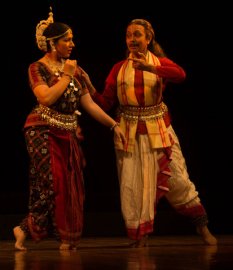 Leelavati Smitalay presented its unique production Leelavati based on famous mathematician, astronomer Bhaskaracharya’s 12th century mathematical treatise. Concept and choreography was by Jhelum Paranjape, script by Avinash Paranjape and music composed by late Anand Modak. Ravindra Sathe excellently rendered the Sanskrit shlokas. The text of Leelavati runs into 261shlokas, but only 11, apart from the invocatory and concluding ones were chosen for this presentation. These shlokas give problems in arithmetic, algebra, geometry, use of fractions and square roots, permutations and combinations, Pythagoras theorem and properties of triangles. 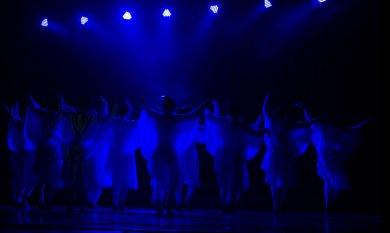 Leelavati The dance is about a day in the life of Leelavati and her mathematician father Bhaskaracharya. It begins with Bhaskaracharya invoking Lord Ganesha. Leelavati then sets out at dawn to collect flowers for puja. Her father joins her. On the way they spot a herd of elephants, a swarm of bees, a flock of swans. Dancers dancing to excerpts from Vivaldi”s Four Seasons gracefully portrayed the elephants, bees and swans. The choreography merged beautifully with the western classical music. The rest of the music was purely Indian. Music director Anand Modak has deftly combined the two. The dance of the bees in their thin gauze like costumes worn over black body-suits was noteworthy. One scene where the bee dancers gather together in a cluster, raise their hands over their heads in the bhramara mudra and move them simulating a swarm of bees was very realistic and effective, also due to the excellent lighting by Arun Madkaikar. Bhaskaracharya asks mathematical questions to his daughter based on these groups and she answers them accurately. They then reach a pond where she collects lotuses for worship. At the temple, her father questions her on the number of flowers offered to the different deities as also on the permutations of the different weapons in the ten hands of Lord Shiva. Leelavati gives the correct answers. The Shiva answer was grandly shown by five male dancers standing one behind the other with outstretched arms and hands in different mudras depicting different weapons. On the way back home, they see a beautiful peacock perched on a pillar and swooping down on a snake. Bhaskaracharya’s agile brain throws up a geometrical problem.This was beautifully shown by three dancers forming a triangle.They pass by a well and he asks a question pertaining to the water contained in the well.The choreography and background music for a game of chess between father and daughter is a visual treat. While asleep, Leelavati dreams of a lover, the swans and their love play, male and female bees humming in unison.This dream sequence was choreographed delicately. Leelavati is woken up from her sleep by her father’s booming voice. The scene ends with a shloka praising both, Leelavati-the daughter and Leelavati-the book. The large audience that evening was very appreciative. They were very involved in the performance and one could hear gasps of delight whenever Leelavati solved a problem. October 18, 2014 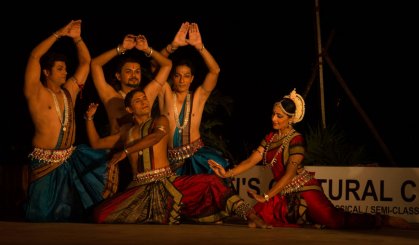 Lord Vishnu on Seshnaag with Goddess Lakshmi 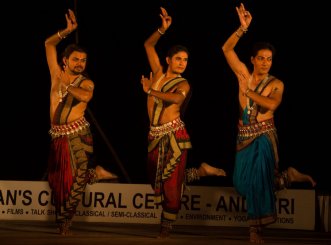 Male students doing traditional Odissi The fourth event was held at Pranganga, the beautiful open air amphitheater at Bhavan’s Cultural Centre. This event was divided into two parts. The first half consisted of traditional Odissi items which were all choreographed by Jhelum Paranjape. The evening commenced with a mangalacharan based on a popular Marathi Shiva stuti, Shambho Shankara performed by Ankur Ballal, followed by Kalavati Pallavi highlighting the delicate fluid nature of Odissi. A group of dancers performed this graceful pallavi, the music for which was composed by Jatin Sahu with mardal inputs by Rohan Dahale and Jhelum Paranjape. It has its share of tricky ukuttas and arasas but what stands out is the fluidity. Both the music and dance were a treat for the eyes and ears. The pallavi was followed by a group dance based on the ashtapadi “Shritakamala” with music by Balakrishna Das, sung by Manoj Desai with Rohan Dahale and Aparna Deodhar accompanying on the mardal and sitar. Eight senior dancers of Smitalay performed this grand choreography. The dancers freeze into a pose showing Lord Vishnu sleeping on the Seshnaag and Goddess Lakshmi at his feet. It looked like a mural on the wall of a temple. They also enacted the story of Krishna killing the poisonous snake Kaliya. Vishnu and Lakshmi sitting astride Garuda is another scene that remains etched in my mind. In the end, they enacted the whole Ramayana from Rama’s wedding to the killing of Ravana in a couple of minutes. 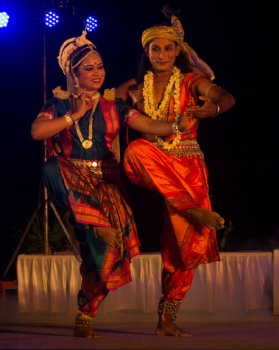
Radha Krishna
The second presentation was called Chitrapat Ke Krishna Kanhaiya. It is the deep attachment between Radha and Krishna, from Krishna’s birth to the moment he leaves Gokul to be part of the Dharmayudh, all narrated from Radha’s perspective. The presentation was based on popular Hindi film songs. Concept was by Shashi Binani, songs were chosen by her and Swapnil Mistry. Out of the fifteen songs, four were choreographed in Kathak style by Shila Mehta. Choreography for the rest was by Jhelum Paranjape in the Odissi style. Starting with the popular song “O palan harey” from the film Lagaan, Krishna is shown as the saviour of mankind. Both Kathak and Odissi and a clever use of lighting brought out the almost ethereal feel of the song. This was followed by the earthy “Nanda gheranand bhaiyo” song announcing the birth of Krishna. Most in the audience wanted to get up and join in the dance. Then we see little Krishna’s pranks in “Bada Natakhat hai re.’ A little older Krishna then complains to his mother in “Yashomati maiya se bole nandlala, radha kyun gori main kyun kala.” There were four krishnas - eight year old Siya, Shweta Mohite, Sumedh Pawar and Sanatan Chakravarty. Dipali Tikam portrayed a jealous Radha very well in “Radhike tu ne bansari churai.” The holi dance based on the song “Holi Aayee” was energetic, wonderfully choreographed by Ankur Ballal. He managed to bring chaos on the stage where at one point the dancers were just a bundle of arms and legs. Krishna danced with gay abandon and he was lost in the music of his own flute. This show really reached out to the common man. It made classical dance palatable for all. Men, women and children of varying ages, all students of Smitalay, participated in this, perhaps the main reason for its mass appeal. October 19, 2014 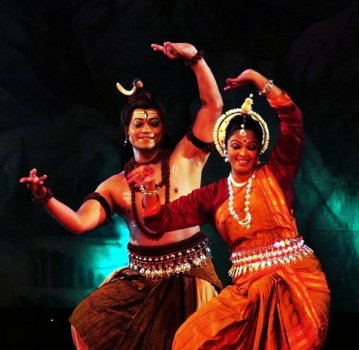
Uma
Darshana Jhaveri was the chief guest for the program held in the morning at Veer Savarkar hall. Smitalay presented ‘Uma’ based on a Marathi poem by Vasant Bapat, inspired by Kalidasa’s Kumarasambhavam. The music was composed by Late Pandit Raghunath Panigrahi and choreography by Jhelum Paranjape. It is about ‘Stree-shakti’ as embodied in Parvati - her determination to do penance to win over Shiva. Why should penance be the prerogative of men, questions the poet. The opening was spectacular. The curtains rose to show a scene of the Himalayas lit up by surreal lighting and dancers forming an Om with their bodies. Parvati is seen with her sakhis. Sage Narada enters and the story unfolds. Parvati doing penance as the seasons change is a very noteworthy scene both in terms of music, dance and lighting.The changing seasons were skillfully depicted by a group of dancers dressed in black with different colored dupattas representing different seasons. Dilip Tambe’s unwavering gaze and unhurried movements made him a powerful and dignified Shiva. He has tremendous stage presence and is able to hold the audience’s attention for a length of time. Ketaki Shetge’s portrayal of Parvati was realistic, exuding a quiet inner strength all through the performance. The Madan and Vasant dance was beautiful. A touch of humour was added by the dance of Shiva’s ganas Shringi and Bhringi. The story ends with Parvati winning over Shiva but the poet Vasant Bapat waxes eloquent about the transformative power of a woman, her creative energy and ability to inspire. This is beautifully shown in the last dance where Shiva and Parvati dance together, Parvati holds centre stage, other dancers move on the floor pointing towards her in awe. The last event of the festival, Student’s Day was held in the evening at Pranganga amphitheatre, Bhavan’s Cultural Centre. As the name suggests, students who have learnt Odissi at Smitalay were given a platform to showcase how they have used their knowledge through their students and /or choreography. The evening commenced with a mangalacharan based on the Shiv Upasanastotra, performed by students of Mitali D’souza who runs a school called Nrityavan. This was followed by a presentation by Sanatan Chakravarty’s students. He has been teaching Odissi to little children for the past three years and they are still into learning basics. So he gave them certain rhythmic patterns of Odissi and asked them to create their own pieces within that framework. He stood on stage playing the mardal. It was interesting to see his students perform their own little pieces of dance. His second group of students were seasoned contemporary dancers from The World Dance Centre, but have just begun learning Odissi. He played a rhythm for them and asked them to choreograph a dance in any style bringing in Odissi wherever possible. It was a fusion of dance forms. Hemangi Pisat teaches dance to mentally challenged children, who have been learning dance from her for the past ten years. She realized that they pick up dance easily when it’s based on popular film tunes. She choreographed on a song from film Singham. Her students gave an amazingly flawless performance. Then came students of Nrityanikunj, an Odissi and Bharatanatyam school run by Ketaki Shetge and Dilip Tambe. Their students did a jugalbandi piece in Bharatanatyam and Odissi called Natyautpati. This story is taken from a chapter of Natya Shastra and based on Prem Joshua’s instrumental music. Nivedita Mukherjee then performed with her students. She runs a school called Aratrika in Thane and Vashi. They performed the Shiva Panchakam in raag Patdeep and taal triputa. This was choreographed by Guru Gangadhar Pradhan. Then Zia Nath, a sufi dancer who has learnt Odissi at Smitalay did a piece called ‘sacred dances’ in which she did the sufi part while four male dancers from Smitalay did the Odissi part. It was based on sufi music from Pakistan. Then Varda and Aparna, both students of Smitalay now based in Pune, performed for shlokas in praise of Lord Vishnu and a piece on Mahishasuramardini stotra. Ankur Ballal, a senior artist of Smitalay presented his piece called Raavan. This was based on the Shiva Tandava Stotram, a very vigorous, fast paced, complicated choreography. The artists of Smitalay did full justice to it and Dilip Tambe as Ravan stole the show. It was heartwarming to see the Smitalay family together. Musicians, sound-record technicians, light-technicians, make-up artists, all were felicitated. Jhelum’s son Bunkim who has written and composed some songs for Smitalay, sang extempore requesting his mother to dance, which she did. 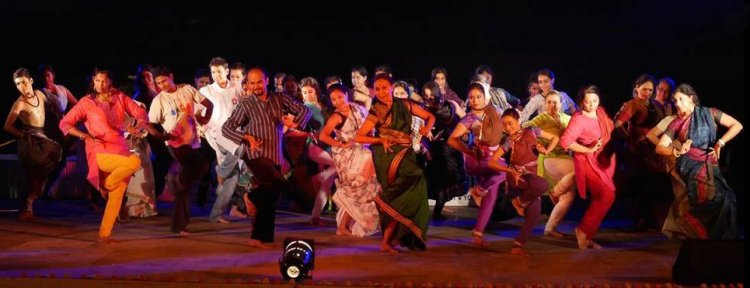 Extempore finale Moksha As we thought that the show has now come to an end, mardal player Rohan Dahale suddenly announced that the Odissi festival had to end with Moksha, he would play and those who wanted to dance could do so. Jhelum and students of Smitalay, past and present, young and old, in saris, kurtas, skirts, danced the unplanned Moksha extempore. It was an exhilarating scene. The finale of the festival celebrating Smitalay’s silver jubilee was amazing with about 40 dancers on stage. |